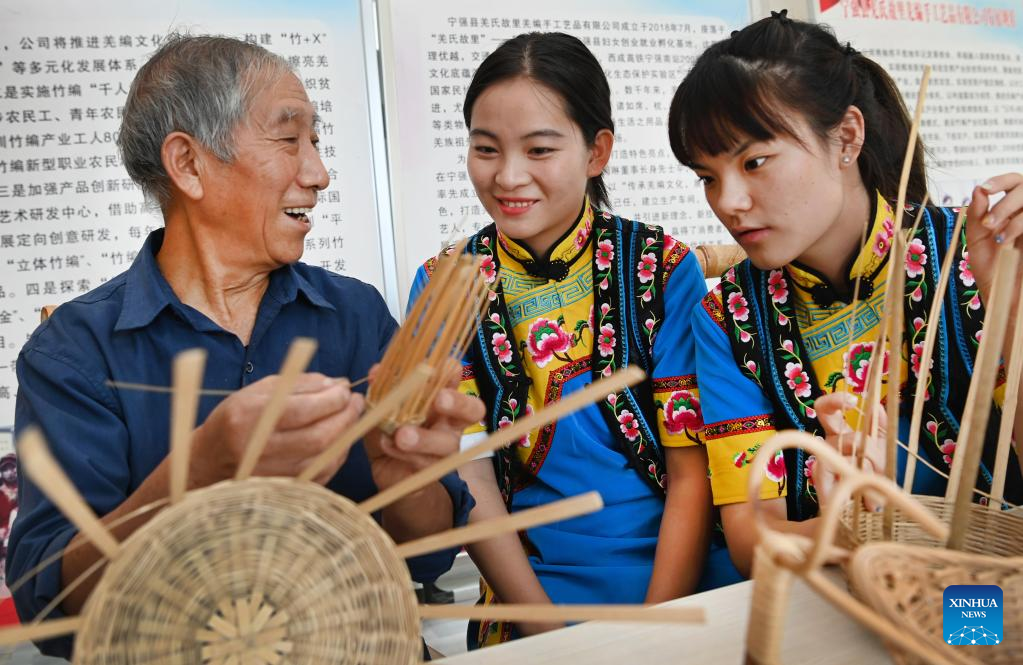Tong Zhengming (1st L), a successor of intangible cultural heritage, displays the bamboo weaving techniques of the Qiang ethnic group in a folk garden in Ningqiang county, northwest China’s Shaanxi province, September 7, 2022. increase. [Photo/Xinhua]
China recently released its cultural development plan for the period of the 14th Five-Year Plan (2021-25), emphasizing that culture is not only the soul of the country, but also the soul of national governance.
One of the main goals of the guidelines is to deeply integrate culture and tourism to provide travelers with a unique experience centered on Chinese culture.
To achieve its goals, the document recommends improving the mechanisms to support such integration, enhancing the role of culture in tourism development, offering a diverse range of tourism products, and supporting the development of the sector. It states that optimizing the environment is important.
The plan has elicited a positive response from the domestic tourism industry, which has been hit hard by the COVID-19 outbreak.
“During the 14th Five-Year Plan, the integration of culture and tourism will enter a more substantial development stage,” said Zhan Dongmei, an associate researcher at the China Institute of Tourism.
Mr Zhan expects the per capita travel rate and the number of tourist visits to continue to increase during the 14th Five-Year Plan, and the travel industry and government authorities will work together to increase the diversity of tourists. I said we need to meet the demand.
“Good tourism offerings should focus on the essence of culture, such as the tourism experience. It is better to provide the offerings that tourists need,” said Zhan.
Wu Liyun, an associate professor at the Chinese College of Culture and Tourism at Beijing Foreign Studies University, agrees.
“The deep integration of tourism and cultural elements, including symbols and stories, not only makes tourism more attractive, but also allows more visitors to learn the beauty of Chinese culture and increase their trust in it. increase.”
“The plan will benefit the domestic tourism industry. The development of new businesses will not only make the tourism sector more competitive and bring new vitality, but also attract more talents and expand the sector. ”
According to Wu, the plan will also help solve problems related to policies that hinder the development of the sector.
“This plan can boost the development of the tourism sector with innovative content and help create a high-quality, diverse and attractive tourism offering,” Wu said.
She said operators will be able to offer more employment opportunities and have the opportunity to improve themselves through the consolidation of their portfolio of related companies and the development of new businesses in the sector. rice field.
Wu said cultural and creative products and immersive performances are just two of the avenues being used to attract young travelers and boost the local tourism sector.
For example, the blind box produced by the Henan Provincial Museum has been a big hit, allowing buyers to experience the excavation process by “digging” the clod contained in the box with a small trowel and looking for antique replicas. . From the museum collection.
In addition, popsicles in the shape of ancient buildings and cultural relics are popular in many scenic spots and museums across the country and are popular with travelers.
Since the epidemic, camping has become more popular because tourists can embrace nature and enjoy it with family and friends without fear of lockdown. It can be combined with multiple businesses, including those that provide tourism, and play an active role in promoting local tourism development.
Scripted murder mysteries are another popular activity among young people in China.
“Several scenic areas and hotels are trying to combine murder mysteries with their offerings in order to extend the stay of visitors. It could be,” she said.

